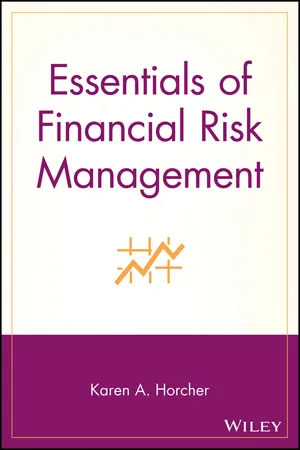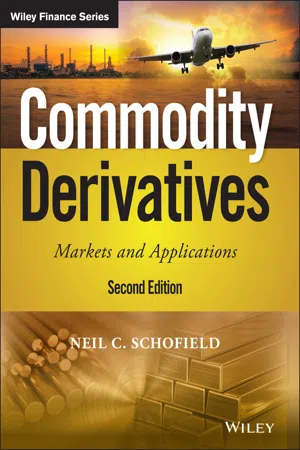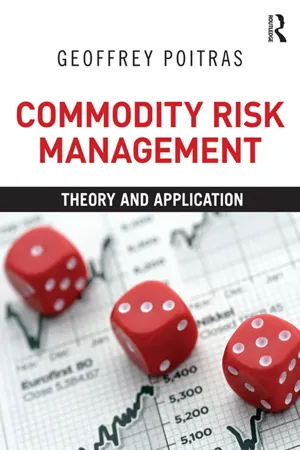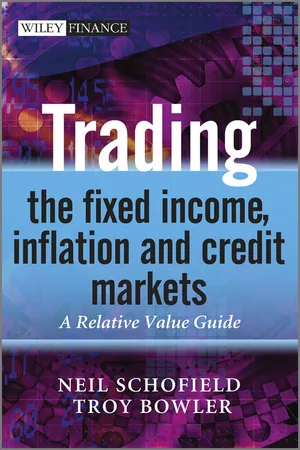Business
Risk of Hedging
The risk of hedging refers to the potential for financial loss or ineffectiveness when using hedging strategies to mitigate risks such as currency fluctuations or commodity price changes. While hedging can protect against adverse market movements, it also carries the risk of incurring costs or missing out on potential gains if the hedging strategy does not align with market conditions.
Written by Perlego with AI-assistance
Related key terms
10 Key excerpts on "Risk of Hedging"
- eBook - ePub
Energy Trading and Risk Management
A Practical Approach to Hedging, Trading and Portfolio Diversification
- Iris Marie Mack(Author)
- 2014(Publication Date)
- Wiley(Publisher)
Hedging strategies generally involve the use of derivatives, such as those introduced in Chapters 2, 3, and 4. Derivatives, when well understood and properly utilized, are beneficial to help energy market participants manage risks through trading and structured hedging strategies. In this chapter we- Discuss the role of hedging in energy trading and risk management
- Lay the groundwork for the next chapter, where we examine how energy derivatives are utilized in various hedging strategies
What is a hedge? What is hedging?HEDGE
A hedge is an investment that reduces the risk of adverse price movements in an asset.Hedging against risk involves the purchasing of financial instruments to offset the risk of adverse price movements.A hedge is an investment that reduces the risk of adverse price movements in an asset. Technically, a basic hedge consists of investing in two assets with a negative correlation (statistical measurement of how two assets move in relation to each other).Hedging against risk involves the purchasing of financial instruments to offset the risk of adverse price movements.If a market participant employs a hedging strategy it may incur an inevitable tradeoff between risk and return.One way to grasp the concept of hedging is to think of it as insurance. When energy and financial market participants implement hedging strategies they are insuring themselves against a negative event. Hedging does not prevent a negative event from occurring. If the negative event does occur and the market participant is properly hedged, then any negative impact should be minimized. In financial and energy markets, hedging is more complicated than the payment of insurance premiums.Regulatory rules may play an important role in hedging strategies (Deng and Oren 2006). In addition, hedging of risk by a corporation is often motivated by the goal of maximizing the firm’s value via the reduction of the - eBook - ePub
- Kenneth M. Eades, Timothy M. Laseter, Ian Skurnik, Peter L. Rodriguez, Lynn A. Isabella, Paul J. Simko(Authors)
- 2010(Publication Date)
- Wiley(Publisher)
The science of financial hedging has become increasingly sophisticated and more quantitative over the years. Understanding how to use financial instruments for hedging therefore requires some study of statistics as well as a close look at the instruments themselves. Even though the objective of hedging might appear straightforward, it was inadequate risk management during the subprime mortgage crisis that ultimately spelled ruin for financial institutions such as Bear Stearns and Lehman Brothers. In these cases the principles of hedging were not flawed, but rather it was the implementation and the underlying assumptions of the risk models that were flawed. Despite these extreme examples, the financial industry and the use of derivatives and financial hedging will continue to be a mainstay of financial strategies in the future. Like the broader topic of enterprise risk management, hedging also has a certain vocabulary that facilitates thinking about risk and whether it should be hedged, and if so, how it should be hedged. With this in mind, the remainder of the chapter is organized as follows:- Risk and statistical analysis.
- Futures and options contracts.
- The hedging decision.
Risk and Statistical Analysis
We start the study of financial hedging with a quick review of how a statistician would describe risk. When asked, most people would define risk as the possibility that something bad will happen in the future. For the study of risk, however, we need to find a more useful and usable definition. Because statistics are a means of quantifying uncertainty as a measure of risk, business managers must think about risk within this framework. Statistics incorporate the study of probabilities within which we can define risk as the uncertainty, both upside and downside, around an expected value. For example, if a business analyst was making a forecast of company sales for next year, the analyst’s best guess would be the expected value around some distribution, as illustrated in Exhibit 15.2 .The expected value is the midpoint of the potential outcomes; that is, it represents the value for which it is equally likely that the realized value will be either higher or lower than the forecast. If the firm performs better than expected, the realized value will fall to the right of the expected value in the “good news” part of the distribution. If the firm performs worse than expected, the realized value will fall to the left of the expected value in the “bad news” half of the distribution. - eBook - ePub
- Karen A. Horcher(Author)
- 2011(Publication Date)
- Wiley(Publisher)
Risks are events and described as high or low probability. If an event occurs, it has the potential for losses that range in size from small to large. Often, one measure is high and the other is low—for example, a high probability of a small loss. This type of loss might be represented by routine exchange rate fluctuations.The most dangerous risks are those with a low probability of occurring but the potential for a large loss. Sometimes known as icebergs, these risks appear suddenly and can result in large losses. The failure of a counterparty and the resultant loss could be an example of such a risk.Once an acceptable level of exposure has been established, management can determine how to reduce the potential for loss to an acceptable level. Competitive LandscapeAn important consideration in making hedging decisions is the expected activity of competitors. If an organization hedges and its major competitors do not, the organization may be at a disadvantage if market rates or prices move favorably. The reverse is also true. If the organization hedges and exchange rates move adversely, the organization may have an advantage over its competitors.Changes to an organization’s pricing structure, as a result of changing costs, may cause customers to buy or consume more or less. Financial risk can sometimes be passed on to customers or end users in the form of price adjustments, reducing the impact to the organization. This is most often possible when demand is inflexible or slow to react to price changes.The activities of competitors and the market affect the competitive landscape in the following ways:- Propensity of customers to accept risk through rising prices
- Willingness of vendors to offer fixed-price contracts or dual-currency pricing
- How products are priced
- Where product inputs, including commodity components, are sourced
- Alternative inputs to products and sources of inputs
- Commodity components
Management typically develops risk management policy, while the board of directors has responsibility for its approval. As representatives of shareholders, the board’s responsibilities include oversight of management. Given the potential for substantial losses, boards are especially concerned about financial risk management and its implications in these key areas: - Torben Andersen(Author)
- 2015(Publication Date)
- Routledge(Publisher)
Treanor, S. D., Simkins, B. J., Rogers, D. A. & Carter, D. A. (2014). Does operational and financial hedging reduce exposure? Evidence from the US airline industry. Financial Review 49(1), 149–172.Passage contains an image
7 Reflections on integrated risk management
Kent D. Miller1DOI: 10.4324/9781315780931-10Risk researchers in the various fields of business have tended to examine particular sources of risk in isolation (Miller, 1992 ). International management researchers highlight risks owing to political and economic instability, government policy changes, or social unrest. Finance researchers focus on managing the categories of risk for which hedging and insurance instruments apply, such as movements in commodity prices, interest rates, and exchange rates. Operations and management researchers consider hazards arising within particular functional activities, across supply chains, and in dynamic markets.A strategic management perspective encompasses all of these concerns, and brings a particular emphasis to the role of competitive strategies in creating and ameliorating organizational risk. Moves by rivals, new entrants, and technological breakthroughs present risks and rewards as they transform industries. Strategists have available a diverse repertoire of possible responses to manage risk, including avoidance or control of risky situations, collaboration with other organizations to reduce uncertainty, imitation or follow-the-leader coordination, and developing operational and strategic flexibility.Strategic managers are uniquely positioned to consider the organization in relation to its environment, and to do so in a way that encompasses intra-organizational, industry, and general environmental risks. Strategic managers are charged with assessing and managing diverse risks, and they need ways to think about, discuss, and carry out these complex responsibilities. My 1998 article, “Economic Exposure and Integrated Risk Management,” contributed to the conceptual framing and methodology of assessing and managing diverse risk exposures in an integrated manner. Viewing the organization in relation to its environment with a view toward enhancing firm value, as that article does, reflects defining concerns in the strategy field.- eBook - ePub
Commodity Derivatives
Markets and Applications
- Neil C. Schofield(Author)
- 2021(Publication Date)
- Wiley(Publisher)
Liquidity risk – liquidity risk can be thought of as the potential inability of a company to meet its short‐term cash requirements. This may arise from the inability to borrow money from its bankers, or the inability to be able to liquidate assets to cover any shortfall.- Commodity risk – simply, this is the exposure that a company will face because of a change in commodity prices. This may be either explicit or as a side product of a company's business. For example, a gold producer will be exposed to a fall in the price of the commodity, which is a direct function of his production. A haulage company's exposure to diesel prices is arguably a secondary exposure to their main line of business. A company that is fully integrated along a particular supply chain will arguably face offsetting price risks.
Credit risk
The other main risk from the ‘big five’ noted previously that can be hedged is credit risk; although the use of credit derivatives is outside the scope of this book.To illustrate the principles let us consider the issues faced by a consumer of base metals within the automotive sector. It would be possible for them to enter direct physical hedging contracts with the producers of the metal, but this is not without difficulty. There would be three main risks that the producers would face. Firstly, there is the issue of product specification. Hedging directly with say a mine is not necessarily a good idea, as they will not be producing the metal in its primary form. It is more likely to be in an intermediate form that needs further work to make it usable by the consumer. Although a physical hedge may be possible with a smelting company, there is still no guarantee that they will be able to produce the metal in the exact specification required. The second issue relates to the counterparty credit risk. If either the mine or the smelter suffers any operational problems, they may not be able to meet their future physical obligations. Finally, there is the issue of price expectations. Consumers of the metal will be looking to hedge at times when the commodity price is at the bottom of the price cycle, while producers will be looking to hedge towards the peak of prices. - No longer available |Learn more
Commodity Derivatives
Markets and Applications
- Neil C. Schofield(Author)
- 2011(Publication Date)
- Wiley(Publisher)
Equity risk: This can arise in a number of different forms from a corporate perspective. Again one source of equity risk could be hidden in a company’s defined benefit pension scheme. Proposed share buybacks and employee share option schemes may require the company to buy equity at an unfavourable price. Investments in other publicly quoted companies gives rise to a form of equity investment risk.• Liquidity risk: Liquidity risk can be thought of as the potential inability of a company to meet its short-term cash requirements. This may arise from the inability to borrow money from its bankers or the inability to be able to liquidate assets to cover any shortfall.• Commodity risk: Simply, this is the exposure that a company will face as a result of a change in commodity prices. This may be either explicit or as a side product of a company’s business. For example, a gold producer will be exposed to a fall in the price of the commodity, which is a direct function of his production. A haulage company’s exposure to diesel prices is arguably a secondary exposure to their main line of business. Companies that are fully integrated along a particular supply chain will arguably face offsetting price risks.2.1.2 Credit risk
The other main risk from the “big five” noted previously that can be hedged is credit risk – although the use of credit derivatives is beyond the scope of this book.To illustrate the principles let us consider the issues faced by a consumer of base metals within the automotive sector. It would be possible for that person to enter into direct physical hedging contracts with the producers of the metal, but this is not without difficulty. There would be three main risks that the producers would face. Firstly, there is the issue of product specification. Hedging directly with, say, a mine is not necessarily a good idea, as the metal will not be produced in its primary form. It is more likely to be in an intermediate form that needs further work to make it usable by the consumer. Although a physical hedge may be possible with a smelting company, there is still no guarantee that they will be able to produce the metal in the exact specification required. The second issue relates to the counterparty credit risk. If either the mine or the smelter suffers any operational problems, they may not be able to meet their future physical obligations. Finally, there is the issue of price expectations. Consumers of the metal will be looking to hedge at times when the commodity price is at the bottom of the price cycle, while producers will be looking to hedge towards the peak of prices. - Kurt J. Engemann, Kurt J. Engemann(Authors)
- 2018(Publication Date)
- Routledge(Publisher)
Organizations typically invest in financial hedging strategies for increasing the certainty of operating margins, reducing negative impacts from currency movements on competitiveness, and facilitating internal contracting. In these cases, a robust FX risk management policy is essential for mitigating unexpected losses in foreign currency derivatives transactions. Examples of financial approaches include currency futures or swaps, foreign exchange binary options, foreign exchange options or swaps and forward exchange rates. Besides these financing tools, cross-hedging approaches may be used in circumstances where there are no hedging instruments between the home and foreign currencies are available. In these circumstances, a third country with a well-developed currency can serve to financially hedge FX risk. Hedging with futures or options and cross-hedging are complex processes, which usually requires working with finance for designing and implementing hedging strategies. However, other organizational functions, including purchasing, marketing and legal, may also have an influence in implementing this strategy. There are operating strategies for managing FX risk. These strategies primarily involve decisions related to production flexibility, sourcing flexibility and natural hedging. Production flexibility allows the firm to alter their mix of supply sources by switching production between plants per observed changes in the currency exchange rate. Sourcing flexibility allows the firm to choose and diversify the firm’s currency mix. Prior studies have examined the role of production flexibility for hedging foreign currency cash flows (Chowdhry and Howe 1999), while Hommel (2003) identified both the strategies of diversification and flexibility in response to currency rate volatility- eBook - ePub
Commodity Risk Management
Theory and Application
- Geoffrey Poitras(Author)
- 2013(Publication Date)
- Routledge(Publisher)
Part 2Commodity Risk Management Concepts2.1Measuring Risk and ExposureA. Risk and Uncertainty B. What is Value at Risk? C. Commodity Basis Risk Characteristics 2.2Optimal Risk Management DecisionsA. Risk Management Objectives B. Transaction Hedging and Optimal Hedging C. Optimal Hedge Ratios for Ex Ante Decisions2.3Strategic Risk ManagementA. What is Strategic Risk Management? B. Designing a Commodity Risk Management Philosophy C. Shareholder Value and Corporate Currency Risk Management D. The Farmer’s Commodity Risk Management Problem … human decisions affecting the future, whether personal or political or economic, cannot depend on strict mathematical expectation, since the basis for making such expectations does not exist.John Maynard Keynes (The General Theory, 1936, Ch. 12)It is sometimes said that hedging is the opposite of speculation. This is not so. They are different kinds of the same thing. The thing that is usually identified as speculation—that is, long or short positions in futures contracts—is speculation in price level. The thing that we identify as hedging—that is, long cash and short futures or vice versa—is speculation in price relationships … Thus hedging and speculation are not opposite; in fact, they are conceptually similar. They are just different kinds of speculation.Thomas Hieronymous (1977, p.151)Passage contains an image 2.1 Measuring Risk and Exposure
A. Risk and Uncertainty1Defining Risk and UncertaintyThe concept of risk is fundamental to many fields of study. Risk appears in numerous guises, from theoretical modeling of financial decisions to determining the social consequences of expanded nuclear power usage. Despite this importance, the precise definition of risk depends on the context and application. Common usage is derived from insurance applications where risk represents the possibility of loss, injury or peril. This definition is reflected in various risk assessment and some risk management applications, ranging from social and psychological risk to environmental and bio-hazard risk. Units of measurement for risk vary with context. In contrast, risk in financial economics is associated with the possibility that the actual return for a real asset or security will differ from the expected return. There is a fundamental tradeoff between risk and return. This financial risk is typically measured using the variance or standard deviation of historical return from the mean return, a definition of risk that includes both positive and negative outcomes. Where only the possibility of financial loss is of concern, as in value-at-risk applications, measurements are evaluated using the left tail of the probability distribution for return or profit. - eBook - ePub
Trading the Fixed Income, Inflation and Credit Markets
A Relative Value Guide
- Neil C. Schofield, Troy Bowler(Authors)
- 2011(Publication Date)
- Wiley(Publisher)
A further consideration when discussing the implied risk of a particular trade is the impact that it will have on the investor's existing portfolio. For example, let us assume that an investor is long UK equities and decides to hedge this by buying puts. Suppose he is going on a business trip for a few days and does not want to leave his portfolio at risk as there is a significant economic release about to be published which might impact the equity market adversely. Regardless of his reason for wanting to hedge, he still likes the equity exposure but wants to protect some of the previous gains. Again, his expectation is that he will lose his entire upfront premium on the put. So, looked at in isolation, buying puts is not a particularly attractive trade, from an expected risk–return perspective. From a portfolio point of view, however, buying puts may be a very smart move indeed.This brings us to the following piece of advice. The implied value of trade cannot be quantified in isolation. The payoff profile from a bullish trade may look great but, if you already have a portfolio of great bullish trades, then does it really have any value? The value of a trade is dependent heavily on its marginal contribution to the overall risk–reward profile of the portfolio. In fact, a well-diversified portfolio may have a combination of both essentially bullish and essentially bearish trades, even if the portfolio manager is bullish. So, the next time you recommend a trade to a client, perhaps try to think of one that fits well into his existing portfolio and not just one that offers a sizeable risk–reward payoff.3.2 Defining Market RiskThroughout this book we will mainly consider two types of financial risk. Our analysis of credit risk will focus on the inability (or unwillingness) of a borrower to repay monies they have borrowed. However, in this chapter we will focus on market risk, which we will define as the risk that something that is owned (an asset) or something that is owed (a liability) changes in value as a result of a change in some market price. Some writers may break this down further into things like FX risk or equity risk, but in essence this is simply a variation on the “big picture” definition of market risk. - Gary Shoup(Author)
- 2013(Publication Date)
- Routledge(Publisher)
Credit risk is the risk of default by one of the parties to a contract. Forwards transacted through the interbank are two-party contracts, with each party maintaining required equity through a credit line. The bank, as an intermediary, is the actual counterparty in the majority of forward trades undertaken by corporate hedgers. Default of forwards is almost unheard of, due to the capital reserve requirements in the international banking industry and the short-term characteristics of the forward market. The futures market is even safer. By utilizing a clearinghouse concept, in which the entire brokerage industry stands behind each contract, defaults in U.S. futures markets have been eliminated in recent history.The swap market, however, is one with a significant amount of credit risk. Because currency swaps are unregulated, not subject to clearing, and arranged between private counterparties, the agreement stands only on the credit worthiness of each party. Good credit is rewarded in the swap market. Companies with strong credit ratings are able to command good swap prices. Those whose credit history is weaker pay premiums as compensation for the added risk accepted by the counterparty.2. Market risk is the risk of a long or short position losing value due to adverse moves in the overall market. In a true hedge, market risk can almost be ignored, since it simply determines which side of the hedge provides the gain and which provides the loss. Of course, some corporate decision makers pay serious attention to their hedge “burdens,” more because of corporate philosophy than because of corporate trading strategy. Of course, market risk is all-important if the corporation finds that it is speculating rather than hedging. Since the difference between speculation and hedging is not always obvious, it is critical to correctly identify long and short positions before placing hedges.3. Liquidity Risk
Index pages curate the most relevant extracts from our library of academic textbooks. They’ve been created using an in-house natural language model (NLM), each adding context and meaning to key research topics.









